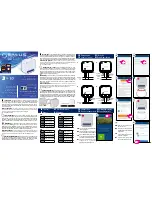
Heater System Solving Guide
FAUL
T CODE THUMBNAILS –
PAGE
F 14
FAUL
T CODE THUMBNAILS –
PAGE
F 14
Heater System Solving Guide
Fault Code Thumbnails LO
Switch Open within Safety Limit String (IDL)
LO
S
WITCH
O
PEN
WITHIN
S
AFETY
L
IMIT
S
TRING
IDL
P
ARTS
T
HAT
M
AY
B
E
N
EEDED
• High Limit Switches
• Control Module
• (Water) Pressure Switch
• Wiring Harness
• Vent Pressure Switch
NOTE: “lo” is normal when pump is off. Otherwise, “lo” means a
control loop switch is open. Therefore, check for the following:
D
IAGNOSTIC
S
EQUENCE
Possibility 1:
Water Pressure Switch Fault
A. To verify that the pump is running, turn the pump OFF and watch to
see that the LO code clears. If LO does not clear, proceed to next step.
B. Verify that water flow rate to heater is above minimum required:
20 GPM for H150--- and H200---,
25 GPM for H250--- and H300---,
30 GPM for H350--- and H400---.
If OK, proceed to next step.
C. Check the water pressure switch for faulty wiring and connections:
Ensure wire harness terminals are securely fastened to spade terminals
on water pressure switch. If OK, proceed to next step.
D. Verify the state of water pressure switch contacts: Remove wire leads
from water pressure switch and jumper leads. Then attempt to oper-
ate the heater, measuring continuity across water pressure switch. If
closed, LO code is not caused by water pressure switch fault. If open,
proceed to next step (after removing jumper from wire leads and re-
connecting wire leads to water pressure switch).
E. Ensure that low pump pressure does not exist. Clean filter or clear
blockages. Check position of valves in plumbing system. If OK pro-
ceed to next step.
F. Adjust water pressure switch setting per instructions in IDL Installation
Manual (only if heater is above or below water level). If LO does not
clear, the water pressure switch is defective and must be replaced.
D
IAGNOSTIC
S
EQUENCE
(
CONTINUED
)
Possibility 2:
Terminal Block Fault
G. Check if a remote on/off device connected to terminal block is open: Turn
remote device on, and watch for LO code to clear. If LO does not clear,
go to step I. If a remote on/off device is not connected to heater, go to step H.
H. Verify that jumper has been removed: If remote on/off control is not used, the
two far-right terminals of terminal block should be jumpered. If jumper is not
present. add jumper. Then, if LO code does not clear, proceed to next step.
I. Inspect terminal block wiring. Ensure wire harness terminals are securely
fastened to terminal block. If OK, terminal block is defective and should be
replaced.
Possibility 3:
Vent Pressure Switch Fault
J. Check the vent pressure switch for faulty wiring and connections: Ensure wire
harness terminals are securely fastened to spade terminals on vent pressure
switch. If OK, proceed to next step.
K. Verify the state of vent pressure switch contacts: Remove wire leads from vent
pressure switch and jumper leads. Then attempt to operate the heater, mea-
suring continuity across vent pressure switch. If closed, LO code is not caused
by vent pressure switch fault. If open, proceed to next step (after removing
jumper from wire leads and reconnecting wire leads to vent pressure switch).
L. Ensure that flue is not blocked or restricted: See indoor vent sizing require-
ments in installation manual. If OK, the vent pressure switch is defective and
must be replaced.
Possibility 4:
Temperature Limit Switch Fault
M.
Check the high limit switch for faulty wiring and connections: Ensure
wire harness terminals are securely fastened to spade terminals on high
limit switch. If OK, proceed to next step.
N. Verify the state of high limit switch contacts: Remove wire leads from
high limit switch and jumper leads. Then attempt to operate the heater,
measuring continuity across the high limit switch. If closed, LO code
is not caused by a high limit switch fault. If open, proceed to next step
(after removing jumper from wire leads and reconnecting wire leads to
high limit switch).
O. Verify that water flow rate to heater is above minimum required:
20 GPM for H150--- and H200---,
25 GPM for H250--- and H300---,
30 GPM for H350--- and H400---.
If OK, the high limit switch is defective and must be replaced.
Finally, remember that the problem could exist
in the wiring harness and also the control module.
F
AULT
C
ODE
T
HUMBNAILS
LO
S
WITCH
O
PEN
WITHIN
S
AFETY
L
IMIT
S
TRING
(IDL)




































